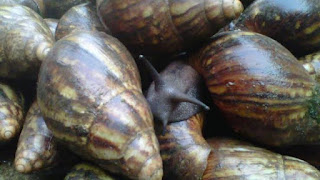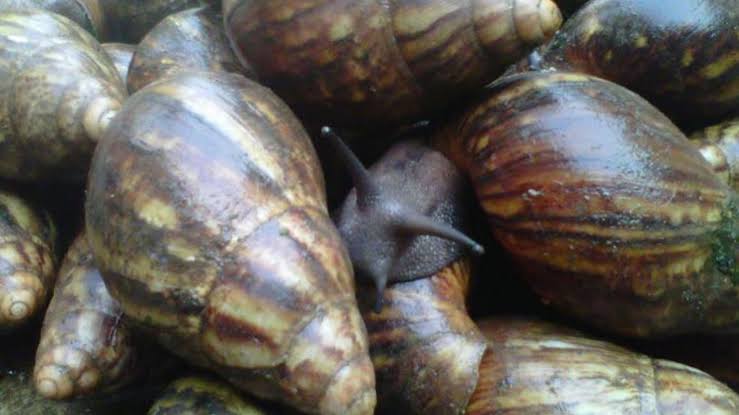Snail Farming as one of the must lucrative business in Nigeria
Snail farming is the business only a few people know about.
It is the act of rearing and producing snails for either consumption purpose or commercial purpose
In Nigeria, this has been detected by a few people, and they are doing beautifully well with it.
If you know how it works and strategically take it serious, it will make numerous increase in your financial performance.
Snail farming can be started, and within the space of 2years, it increases and become very large.
You can also read about Fish Farming in Nigeria and what is need to have a lucrative venture
Most people believe snails can be seen only in the Forest.
No, snails can be seen even in backyards and environments.
Contents
SPECIES OF SNAIL
 |
| Snail farming in Nigeria |
They have different species, but in Nigeria we basically have;
- ACHATINA ACHACHATINA.
- ACHATINA IMMACULATA
- ACHATINA FOLLUCA
1. ACHATINA ACHACHATINA
This is the largest specie of the snails in Nigeria.
It has the biggest size and in rearing, it is the advisable size to patiently wait for, before selling out the snails.
Shape
Among the three species, generally, they have pointed apex, but the Achachatina, it has a blunter apex.
Skin Texture
They have smaller and lighter pores compared to other species.
Eggs
Achatina Achachatina because of their size, lay the biggest size of eggs.
Their eggs are of the sizes of Lizard eggs.
They lay between 6-20 pieces in batches with 12mm- 20mm in diameter.
Achatina Achachatina laying its eggs for catching.
Generally, when they are exposed to optimal weather and good environment can reproduce ones in a month.
2. ACHATINA IMMACULATA
This is the next in size following the biggest size, Achatina Achachatina.
Shape
They have pointed apex, but are not as pointed as the Achatina Folluca.
Skins Texture
Achatina Immaculata has ticker and denser pores than the Achatina Achachatina.
Eggs
They lay eggs between 4-10mm diameter and 20-200 batches (unlike the Bigger specie which can only produce 6-20 per batch.
Achachatina Immaculata. (Second size or Medium among the three common species in Nigeria).
3. ACHATINA FULLICA
This is the least among the species commonly seen in Nigeria.
They have the smallest size and take a longer time to grow.
To start with this, it takes a longer time of rearing.
Shape
Achatina Fulica physically has a long and narrow shell which is two times as longs as it is wide, and contains 7-9 whorl when fully grown.
Skin Texture
The shell of Achatina fulica is known to be reddish-brown in colour with weak yellowish vertical markings. Colouration varies with the environment, coffee colour is common.
Eggs
Its eggs range from 4.5mm-5.5mm in diameter.
It only hatches at a temperature above 15°c.
Achatina Fulica.
Things To Consider Before Going Into Snail Farming
Quarantine your farm properly, to avoid attacks from external bodies and predators. Like a lizard, snake, soldier ants, Etc. Provide well coverage environment covered with a net for them not to escape and not to be prey.
1. Avoid direct sunlight
It is advisable they are covered with a trampoline for proper coverage and surrounded with shaded trees.
They should be shared into segments, according to their sizes and categories.
For easier and proper monitoring and care, if there are ones that are unhealthy.
Properly separating them gives a better and easier way to maintain them.
A Conducive and productive environment for snail farming.
2. Keep the farm wet/ Moisturized Environment
ls are conducive in a wet environment.
Moisturized environment with a moderate amount of water mixed with loamy soil is best for the snail’s comfort.
To avoid too much of water, loamy soil is introduced to them and banana leaves help in absorbing water too; which gives absolutely moderate amount of water and keep them moisturized.
Snails Behave well in Moisturized Environment with loamy soil.
3. Feeding
Generally, snails feed on organic products, reach in protein, and for them to grow fast, there is a formula used in feeding and preparing their food. The more money you give it, the higher growth they attain.
But, if there is no enough fund, they can feed on leaves and vegetables.
They are herbivores, they can feed on water leaves, mangos leaves, cocoyam leaves, carrot leaves, lettuce leaves, carrot, and they feed well on watermelon, both it’s the audible and outer part, banana leaves (which also serve as protection, for the water absorption).
They should be fed with dry leaves because they would serve as protection to the snails from being exposed to much water.
They can be fed with organic feed, mixed from different products. They need a diet rich in protein, to grow.
Preferable, Moringa is known for its medical properties and its richness in protein.
Fresh Moringa leaves contain as much protein as an egg, dry Moringa leave contains four times more.
4. There Growth And Maturity
Snails are reared from the egg.
You can start selling your snails are as early as six months or eight months.
Depending on the size you prefer and the volume you want.
It is advisable, to keep the snails for at least two years for larger volume as starters.
Snails do not hatch often, it bears only ones in a year, and more profitable to hatch naturally without artificial incubation.
Generally, it would only take two years for them to become matured and ready for consumption or sales, but, if it is started with a good amount of adult snails, the time is shortened.
While if it is started with a small amount due to capital, it takes a longer period, for it to become macro and have a large volume.
They lay between two to three months.
Their growth depends on their feeding, if fed well, they will grow healthy and worth selling at a shorter period.
Advantage Snail Farming
- Snail farming in our economy today doesn’t require many funds to start.
- Snails can be gotten in forest or backyards.
- They can be gotten with a little amount of money, while they grow.
- They feed on naturally available supplements, like vegetables, carrots, watermelon, Moringa leaves which serve as both medical nutrient and rich in organic feed expected in feeding them(a rich source of protein
- It doesn’t require much labour.
- It can be done at the comfort of your home.
- No capital needed than that of getting the snails
- Other means of keeping them, is a basket. They respond well in brackets, as it has ventilation and it is affordable.
- Both youth and adults can do it, it doesn’t require much work, then care and maintenance.
Disadvantage Of Snail Farming
- One of the disadvantage in snail Farming is massive death of the snails.
- If they are not maintained or left for days without feeding, they will die largely.
- The Outcome of a snail farm that wasn’t properly fed and maintained.
In conclusion
snail farming is also a great source of income and should be inculcated for a lower rate of unemployment in our society. With the above steps and methods of snail farming, you will ensure a good and successful fish farm.

